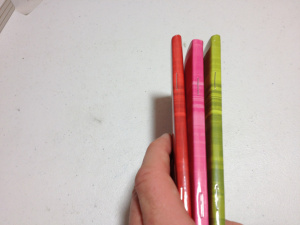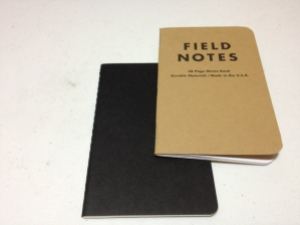Okay, enough with separate reviews, they have their place, but it’s time for an ultimate black pocket-sized notebook show down. We’ve got a couple slots for easy comparisons and five different books to do today.
Rhodia Webnotebook
Paper: Great, smooth, thick, fountain pen resistant, archival quality.
Cover: Faux leather, smooth, easily damaged but solid.
Spine: Hardy, doesn’t crease, folds tightly.
Other: Bookmark and back pocket, well put together. Elastic strap.
Size: 3.5 X 5.5
Notes: Has some minor bleed though issues, really dark yellow papers.
Price: $20


Moleskine pocket
Paper: Thin, bleeds easily, archival quality.
Cover: Pleather, hard cover, like a rock.
Spine: Nice, creaseable, starts to wear near the end of the books life.
Other: Book mark and back pocket. Elastic strap.
Size: 3.5 X 5.5
Notes: Yellowed pages.
Price: $15


Leuchtturm 1917
Paper: Medium thickness, bleed resistant, but shows through a lot, rough paper.
Cover: Thin, a little flexible, but sturdy.
Spine: Creases easily, but is sturdy, paper could peel off.
Other: Back pocket, bookmark, elastic strap.
Size: 3.5 X 6
Notes: Numbered pages, table of contents, perforated pages.
Price: $12


Gibson Markings
Paper: Dark yellow, little bleeding, some show through.
Cover: Thick, damageable, bends easily, has stitches around the sides.
Spine: Works well, but creases, is fragile, and can break.
Other: Back pocket, elastic strap, bookmark.
Size: 3.5 X 5.5
Notes: Not very smooth paper.
Price: $5


Wal Mart Leatherette Journal
Paper: White, shows through really badly, but doesn’t bleed easily. Not the smoothest.
Cover: Thick, ridged, but flexible, with stitching around the outside.
Spine: Alright, but could crack and fall off.
Other: Back pocket, elastic strap, bookmark.
Size: 3.5 X 5.5
Notes: Elastic strap came off after limited use. Cheap construction. Ink for lines was run off on some pages.
Price: $3













